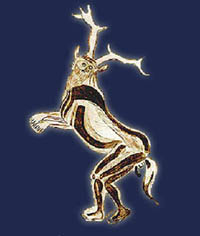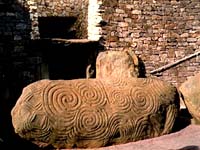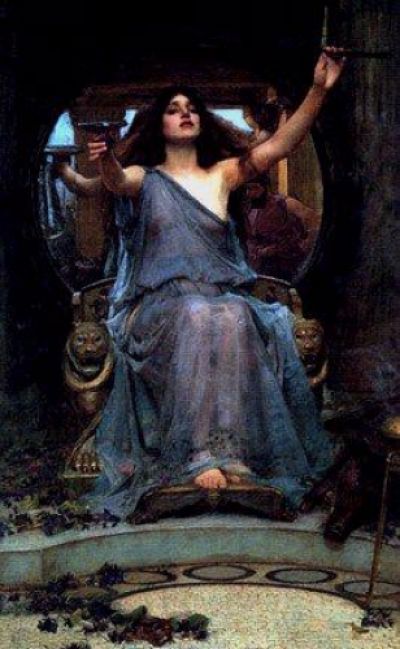|

First of all I'd like to explain what exactly Paganism
is. Originalaly Paganus was Latin for "country dweller". When the Christians were converting Europe, they started in the cities,
leaving the Country Folk to be converted last. So the term Country Dweller ended up meaning, the people of the 'Old Religion'
(AKA those who worshiped the Old Gods, usually focused on fertility gods).
The Old People believed that the Earth is our Mother, and the Great Goddess. Her counterpart was the Horned God,
or the Green Man. Together, they represent every aspect of nature. Goddess is Form, and God is force. The Old People celebrated
nature, and lived by it's rules. 30,000 years ago, before agriculture, and during the end of the Ice Age, the Paleolithic
Peoples, also known now as PaleoPagans, worshiped only the Mother Goddess, sometimes called Danu. They may not have understand
that it took a fertile male force to create life aswell. This was a tribal society, much more than the Celts. Everntually
they began to recognize a god, and made him god of hunting. And then when agriculture was developed, he became a God of Agriculture.

Old Fertility Mother Goddess figurine, found in many places all over Europe.
Dating back as early as 35,000.
The Horned God, found
in Caves of France, dating back as early as 25,000 BC

The Celts were the people that came from the east, perhaps Russia.
The people native to the western europian lands, were thought
of as the Fae, an Ancient Folk, an Ancient Divine Race. Some call them them the Tuatha de Danann. The Celts came and
ruled most of Western Europe, mainly Ireland, Scotland and Britain and Gaul. The pre-Celts natives to the British Iles were
the most likely ones responsible for great works such as Stonehenge, though there is little doubt that the Druids used it
as a temple of sorts once the Celts arrived. Many scholars believe that Stonehenge was made to represent the union between
the Goddess and the God on MidSummers Day, (June 21).

The Druids the priests and priestesses of the Celts. Many have thought there
were no women druids, but this is very inaccurate. We can not be sure how many there were in comparison, but much literature
and mythology shows significant evidence that there were many woman druids, and the Irish called them Ban-Druhai. If you know
anything about Celtic Societies, it would make absolutely no sense that there would not be female clergy in this world, as
they were honored by society, the Goddess was very important, sometimes more important than the God in certain tribes, etc
and so forth. I would not be surprised if there were not more female druids than male, but they were just simply ignored in
modern times after 1700 years of spiritual masculine domination.
The rest of Europe
was Pagan, however, in different ways than the Celts. The Norse had a very highly evolved system of religious beliefs and
a pantheon of Gods. The Romans and the Greek had similar philosophy and a very similar set of Gods, though there is a great
deal of evidence that not everyone of these civilizations were even religious, and possibly atheist. However
much of the world at this time was polytheistic, or at least had a belief in a type of animism.
When the Christians came, the Druids and the Christians worked together in harmony, with the
understanding that they both worshiped and lived under one god, but many gods. They, at that time, respected each other.
In the late 3rd Century AD, Constantine converted to Christianity, which had a rippling effect throughout the
remainder of the empire. Many became rigid and oppressive and began to ignore the fact that most of the land was still of
the Old Religions. In Ireland, Bishop St Patrick 'drove all the serpents out", which simply meant the Druids, for the serpents
were a sacred animal to them. St Patrick also caused what we call the first of the Burning Times. He stood and observed his
people go to each of the men and women of Ireland and ask them if they accepted Jesus Christ as thier One Savior, and if they
replied no, thier heads would be chopped of. He continued to do this in Britain, but with less harsh tactics. This was in
the 5th century, and much of the land was Christianized by force.
However, one must not believe that it was all by force and domination. Many Christian priests, monks and nuns all over
Europe were helping those in need. This showed the merciful side of God, and many Pagans accepted this as merely another God,
and some choose to devote thier life to him and his son, Jesus Christ.
The Christian priests came to a delema. They could not convert the country people, the 'Pagans'. Many began to tell the
world that the Goddess was a deamon and the God Satan himself. They began to threaten the people with damnation of hell, and
so on. The people became afraid for thier souls, but did not want to give up thier old traditions, such as sabbots, celebrations,
bel-fires, ect. So the Church allowed the society to emprovise. They took all of the 8 sabbots of the seasons that were celebrated,
and many other traditions and slowly but surely turned them into Christian holidays.
Examples:
Yule was the winter
holiday, the winter solitice, on December 21. The Christians decided to place the birth of Jesus on the 25th, even though
it was originally in the summer, july. They took all the Yule traditions and merged them into Christmas, such as the Yule
log, the Yule/Christmas tree, presents, and mistle toe. Yule was the "rebirth of the Sun" while Christmas was the "birth of
the son". Strange how that works out doesn't it?
Summer Soltice
(june 21) was changed into St Johns Day.
Lughnasahd, (Aug 2, the
Grain and Bread harvest festival) was changed into Lammas.
Samhain,(October
31, the holy day of the dead) was changed into All Saints Day or Halloween.
Imbolic(Feb 2, the day of candles and honor to the goddess Brigit)
was changed into Candelmas, where the Catholics bless thier candles, as well as St. Brigit's Day, or Brides Day. St. Brigit
was never an actuall saint at all, but a made up woman based on the story of the Irish/Tuathan Goddess Brigit. The Irish loved
her so, they would not give her up.
Ostara/Spring Equinox(March
21, a day where eggs and rabits of fertility were the main symbol) was changed into Easter, the day Jesus was risen from the
dead. Ostara was a day of renewal, fertility and rebirth, and now Easter is a day of rebirth and ressurection.
Beltaine was turned into May Day. They would dance around large bale-fires, and perform fertility
rites such as the "Great Rite" They would also dance around the may pole, which was a phalic symbol.
And those are only a few examples.
In
time most of Europe was Christian, except a few remaining secret societies and family traditions.
In the 14th
century Pope of Bull, Innocent, hired 2 Inquisitioners, to write a book called Malius Malificirum, which means in latin 'The
Witches Hammer'. This book was the mark of the begining of a very dark time. It told many of the lies about the Old Religion
and of witchcraft that are still thought of today. It told that witches were evil, mostly women, worshiped and had sex with
the devil, turned into cats, and so on and so forth. The book told how to find the witches, by the devils mark, by certain
things in thier houses, and what they acted and looked like. Obviously, these things were a gereralization of the people that
they feared, and anyone could fall under this catagory. So women who lived alone, and had herbs in thier house, and some of
thier neighbors didn't like them were accused of witchcraft. The book also told how to torchure the accused and force them
to reveal other witches. Thus, leading to a never-ending cycle. If the 'witch' did not admit her guilt, and reveal other witches,
she would be torchured in a horrible and cruel fasion, and then killed. One torchure method was Scottish Penywinks, which
was a seat of hot iron spikes, heated from below, and they would pull the witch's elbows behind her back until they broke
off. Another one was slowly breaking of pieces of thier shins, or the old torchure methods, burning, drowning, cutting up,
ect. (By the way, men were accused too, but not as much. It was more like a women's holocost than a witches'). One of the
most common ways of eventually killing the witch was hanging, burning or crushing them to death. But sometimes they had a
more 'creative' way. They would throw the accused into a river or lake. If the accused drowned, they were not a witch and
"God would save His own", if they floated, then obviously they were a witch, and must be killed in some other manner. They
would cut the witch, if she bled to death and died, oh well, she will be saved. But if she didn't bleed, she must be a witch!
Many people claim
that a million witches were killed during the 'Burning Times' but that is not very accurate. It is probably more close to
100,000 but there is no way to be sure for not many records were kept. This went on for many many years, mostly until the
18th century. But it wasn't until 1951 that the laws against witchcraft were finally repealed in England. Even in America,
many 'witches' were killed, and not just in Salem. But still even in this day, hundreds are killed for witchcraft every year
in South Africa.
In the late 1800's occultism became to grow into the media a bit. And then Marrgrot Murray, anthropologists of
the early 20th century began to discover the truth about witchcraft and the 'Old Religion' and revealed it in many books.
She talked about the worship of the Goddess mostly, and how it effected life many years ago.
In the 50's, with the help of well known occultist Aleister Clrowley,
Gerald Gardener took his tradition of witchcraft, from his coven he worked in, and started the movement called "Wicca". Wicca
was a modern version of old Pagan and Witchcraft ways, and from this sprung thousands of traditions all over the world. If
you are interested in reading his works, I would suggest "Witchcraft Today", which I believe is out of print. However, you
can also purchase a book called "The Witches' Bible" which is a collection of beliefs, theories, and rituals used by the Gardnarian
Tradition.
Over time Wicca became more popular, but Wicca is only one sect of
what we now consider Paganism. For a while Paganism was considered (due to stereotypes) practitioners of Satanic
beliefs, or the more popular belief that Pagans did not believe in any god, and was closer to an Athiest. Now when we think
of Pagan, we think of a nature based religion. This includes Wicca, Shamanism, Northern Traditions, Druidism, Native American
Beliefs, Celtic Traditions, any belief or religion that focuses to reflect their life with nature.
However, I must point something out. There are many types of Satanism, and I know very little
of them, but I will say that some sects of Satanism could very well be considered Nature Based or Pagan. Many Witches
and Wiccans will claim that they are not Satanic and it is a god awful thing to be associated with Satanists, however most
of them do not have the slightest clue what any form of Satanism is. A Witch can be Satanic, just as a Witch can be Christian,
Wiccan, or Hindu. To read more about Satanism go to the Church of Satan or Lucifarianism to understand more about these very
misunderstood belief systems.

|






